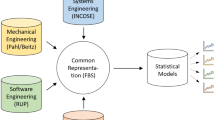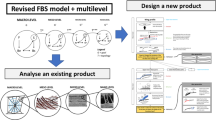Abstract
The paper presents the approach for modeling actions in the dynamic processes of engineering design in microelectronics and integrated circuits domain. It elaborates the formal framework for representing processes, the states of these processes and process environments, the actions being the constituents of the processes. Presented framework is implemented as the part of PSI suite of ontologies and is evaluated using three different methods: user evaluation, formal evaluation, and commonsense evaluation following PSI shaker modeling methodology. The suite of PSI ontologies is used for representing dynamic engineering design processes in Cadence Project Planning Expert System software prototype.
Access this chapter
Tax calculation will be finalised at checkout
Purchases are for personal use only
Preview
Unable to display preview. Download preview PDF.
Similar content being viewed by others
References
Van Staa, P., Sebeke, C.: Can Multi-Agents Wake Us from IC Design Productivity Nightmare? In: Mařík, V., Vyatkin, V., Colombo, A.W. (eds.) HoloMAS 2007. LNCS (LNAI), vol. 4659, pp. 15–16. Springer, Heidelberg (2007)
Sohnius, R., Jentzsch, E., Matzke, W.-E.: Holonic Simulation of a Design System for Performance Analysis. In: Mařík, V., Vyatkin, V., Colombo, A.W. (eds.) HoloMAS 2007. LNCS (LNAI), vol. 4659, pp. 447–454. Springer, Heidelberg (2007)
Mueller, E.T.: Commonsense Reasoning. Morgan Kaufmann Publishers, San Francisco (2006)
McCarthy, J., Hayes, P.J.: Some Philosophical Problems from the Standpoint of Artificial Intelligence. Machine Intelligence 4, 463–502 (1969)
Shafer, G., Gillett, P.R., Scherl, R.B.: The logic of events. Ann. Math. Artif. Intelligence 28(1-4), 315–389 (2000)
Mueller, E.T.: Event Calculus Reasoning through Satisfiability. J. Logic and Computation 14(5), 703–730 (2004)
Ermolayev, V., Keberle, N., Matzke, W.-E., Sohnius, R.: Fuzzy Time Intervals for Simulating Actions. In: Kaschek, R., Kop, C., Steinberger, C., Fliedl, G. (eds.) UNISCON 2008. LNBIP, vol. 5, pp. 429–444. Springer, Heidelberg (2008)
Ermolayev, V., Keberle, N., Matzke, W.-E.: An Ontology of Environments, Events, and Happenings. In: Proc. 31st IEEE Annual International Computer Software and Applications Conference (COMPSAC 2008), pp. 539–546. IEEE Computer Society, Los Alamitos (2008)
Sandewall, E.: Features and Fluents. The Representation of Knowledge about Dynamical Systems, vol. 1. Oxford University Press, Oxford (1994)
Bock, C., Gruninger, M.: PSL: A semantic domain for flow models. Software and Systems Modeling Journal 4, 209–231 (2005)
Workflow Management Coalition. Workflow Standard. Process Definition Interface – XML Process Definition Language. V. 2.00, Doc. No. WFMC-TC-1025 (Final), October 3 (2005)
Ermolayev, V., Jentzsch, E., Karsayev, O., Keberle, N., Matzke, W.-E., Samoylov, V., Sohnius, R.: An Agent-Oriented Model of a Dynamic Engineering Design Process. In: Kolp, M., Bresciani, P., Henderson-Sellers, B., Winikoff, M. (eds.) AOIS 2005. LNCS, vol. 3529, pp. 168–183. Springer, Heidelberg (2006)
Ermolayev, V., Jentzsch, E., Keberle, N., Sohnius, R.: Performance Simulation Initiative. Meta-Ontology v.2.2. Reference Specification, tech. report PSI-ONTO-TR-2007-4, VCAD EMEA Cadence Design Systems GmbH (2008)
Ermolayev, V., Keberle, N., Matzke, W.-E.: An Upper-Level Ontological Model for Engineering Design Performance Domain. In: Li, Q., Spaccapietra, S., Yu, E., Olivé, A. (eds.) ER 2008. LNCS, vol. 5231, pp. 98–113. Springer, Heidelberg (2008)
Masolo, C., Borgo, S., Gangemi, A., Guarino, N., Oltramari, A.: WonderWeb Deliverable D18 Ontology Library (final). In: ICT Project 2001-33052 WonderWeb: Ontology Infrastructure for the Semantic Web (2003)
Niles, I., Pease, A.: Towards a Standard Upper Ontology. In: Guarino, N., Smith, B., Welty, C. (eds.) Int. Conf. on Formal Ontologies in Inf. Systems, vol. 2001, pp. 2–9. ACM Press, New York (2001)
Fellbaum, C. (ed.): WordNet: An Electronic Lexical Database. MIT Press, Cambridge (1998)
O’Donnel, F.J., Duffy, A.H.B.: Design Performance. Springer, London (2005)
Malone, T., Crowston, K.: Toward an interdisciplinary theory of coordination. Center for Coordination Science, Technical Report 120, MIT Sloan School of Management (1991)
Nagendra Prasad, M.V., Lesser, V.R.: Learning situation-specific coordination in cooperative multi-agent systems. Autonomous Agents and Multi-Agent Systems 2(2), 173–207 (1999)
Ermolayev, V., Jentzsch, E., Keberle, N., Sohnius, R.: Performance Simulation Initiative. The Suite of Ontologies v.2.2. Reference Specification. Technical report PSI-ONTO-TR-2007-5, VCAD EMEA Cadence Design Systems, GmbH (2007)
Guarino, N., Welty, C.: Supporting Ontological Analysis of Taxonomic Relationships. Data and Knowledge Engineering 39(1), 51–74 (2001)
Guarino, N., Welty, C.A.: A Formal Ontology of Properties. In: Dieng, R., Corby, O. (eds.) EKAW 2000. LNCS, vol. 1937, pp. 97–112. Springer, Heidelberg (2000)
Keberle, N., Ermolayev, V., Matzke, W.-E.: Evaluating PSI Ontologies by Mapping to the Common Sense. In: Mayr, H.C., Karagiannis, D. (eds.) Proc. 6th Int’l Conf. Information Systems Technology and its Applications (ISTA 2007). GI LNI, vol. 107, pp. 91–104. GI Bonn (2007)
Author information
Authors and Affiliations
Editor information
Editors and Affiliations
Rights and permissions
Copyright information
© 2009 Springer-Verlag Berlin Heidelberg
About this paper
Cite this paper
Ermolayev, V., Keberle, N., Jentzsch, E., Sohnius, R., Matzke, WE. (2009). Modeling Actions in Dynamic Engineering Design Processes. In: Yang, J., Ginige, A., Mayr, H.C., Kutsche, RD. (eds) Information Systems: Modeling, Development, and Integration. UNISCON 2009. Lecture Notes in Business Information Processing, vol 20. Springer, Berlin, Heidelberg. https://doi.org/10.1007/978-3-642-01112-2_14
Download citation
DOI: https://doi.org/10.1007/978-3-642-01112-2_14
Publisher Name: Springer, Berlin, Heidelberg
Print ISBN: 978-3-642-01111-5
Online ISBN: 978-3-642-01112-2
eBook Packages: Computer ScienceComputer Science (R0)




